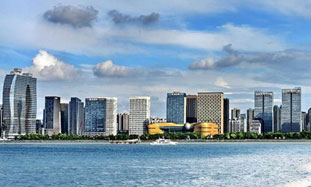Hangzhou, a city with its own unique kind of beauty
Culture
Hangzhou boasts a long history and great cultural wealth. Its culture features the landmarks of the city, like West Lake, the Grand Canal and the Qiantang River and embraces integration and development in an open and innovative era.
The West Lake Culture absorbed the essence of local culture in different epochs, such as Kuahuqiao Culture, Liangzhu Culture that dates back to 3310 - 2250 BC, Wuyue Culture, and the cultures of the Southern Dynasty (1127-1279), Ming and Qing dynasties (1368 - 1644, 1644 - 1911) and the Minguo era (1912-1949).
West Lake Culture covers a wide range of elements, including landscape, gardening, religion, architecture, celebrities, folk customs, the Silk Road, tea and cuisine, all coming together in delicacy and harmony.
The Canal Culture, which integrates the specialties, waterscape, local opera and temple fairs, shows the openness, inclusiveness and popularity of Hangzhou Culture.
Qiantangjiang Culture is as magnificent as the tidal bore of the Qiantang River.
Geography & Climate
As the capital of Zhejiang province and its economic, cultural, science and educational center, Hangzhou is one of the central cities in the Yangtze River Delta. It also ranks among the first batch of National Historical and Cultural Towns crowned by the State Council.
Located in the southern wing of the Yangtze River Delta, at the western tip of Hangzhou Bay, it is the crossing point of the extension of the Silk Road Economic Belt and the 21st Century Maritime Silk Road, and a strategic hub along the Online Silk Road. Situated at the juncture of 29°11’-30°34' North and 118°20’-120°37' East, Hangzhou features a perfect blending of hills and water, and lakes and town, with its harmonious rich water resources of rivers, canals, lakes, sea, creeks. Hilly or mountain areas, largely concentrated in the west, middle and south, account for 65.6 percent of its territory. Its plains amount to 26.4 percent, mainly found in the northeast; and the surface area of rivers, lakes and reservoirs takes up 8.0 percent. Hangzhou boasts the largest reservoir in China's southern coast -- Qiandao Lake. Traversing the city is the world's longest artificial canal -- the Beijing-Hangzhou Grand Canal, and the Qiantang River, widely known for its spectacular tidal waves.
Hangzhou enjoys a subtropical monsoon climate with distinct seasons, ample sunlight and rainfall, more in spring and autumn and less in winter and summer.
Administrative Division
Under the jurisdiction of the city of Hangzhou are nine urban districts, namely Shangcheng, Xiacheng, Jianggan, Gongshu, Xihu (West Lake), Binjiang, Xiaoshan, Yuhang, and Fuyang, two county-level cities -- Jiande and Lin'an -- and the two counties of Tonglu, and Chun'an. Together they enclose a total of 190 towns (subdistricts), of which 23 are townships, 75 towns, 92 subdistricts, 1,072 communities, 34 residential quarters and 2,043 administrative villages. The city covers a total area of 16,596 square kilometers; 4,876 of them are urban.

 Print
Print Mail
Mail
 20 Cultural Symbols
20 Cultural Symbols Why Zhejiang
Why Zhejiang Experiencing high-tech products at WIC
Experiencing high-tech products at WIC Zhejiang Release
Zhejiang Release Zhejiang News
Zhejiang News